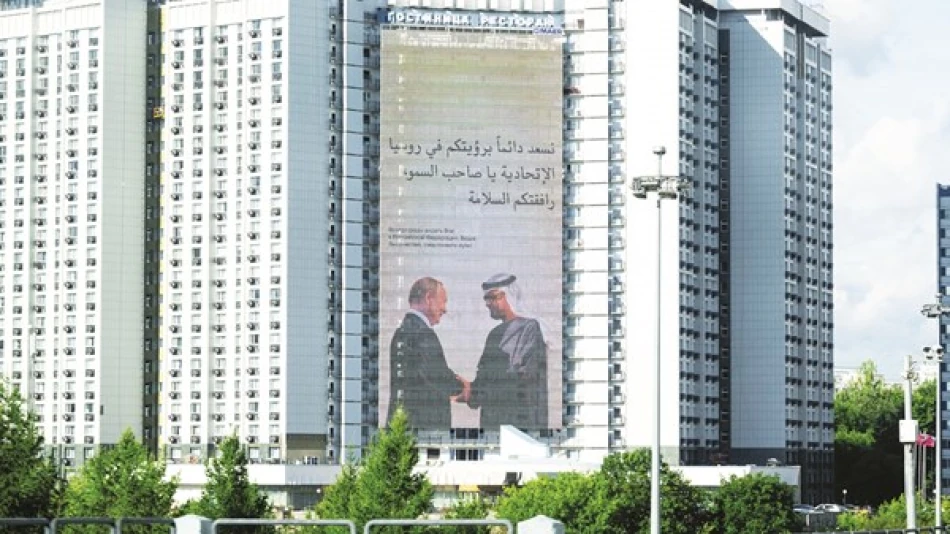
UAE and Russia: A Warm Welcome Reflecting Robust Bilateral Ties
UAE President's Moscow Visit Signals Deepening Gulf-Russia Energy Partnership Amid Global Realignment
Sheikh Mohamed bin Zayed Al Nahyan's state visit to Russia has been marked by extraordinary diplomatic pageantry, with Moscow rolling out the red carpet in a display that underscores the UAE's growing strategic importance as a non-Western energy partner. The visit comes as both nations seek to diversify their economic relationships away from traditional Western markets, potentially reshaping Middle Eastern geopolitics and global energy flows.
Diplomatic Theater Reveals Strategic Priorities
The Russian Federation's reception of the UAE President went beyond standard diplomatic protocol. Moscow's streets were adorned with Emirati flags and Arabic-language welcome banners, while military aircraft escorted the presidential plane into Russian airspace—a honor typically reserved for the most crucial strategic partners.
The ceremonial flourishes at Vnukovo Airport, complete with honor guards and dual national anthems, signal Russia's recognition of the UAE as a critical bridge between Moscow and the broader Gulf region. This level of diplomatic theater suggests both nations view their relationship as transcending mere bilateral cooperation.
Energy Partnerships Drive Economic Realignment
Beyond Oil: A Diversified Strategic Partnership
While energy cooperation forms the backbone of UAE-Russia relations, their partnership has evolved into a multifaceted alliance encompassing technology transfer, defense cooperation, and investment flows. The UAE's sovereign wealth funds have increasingly looked toward Russian assets, particularly as Western sanctions create arbitrage opportunities for non-aligned investors.
This dynamic mirrors similar strategies employed by other Gulf states, notably Saudi Arabia's deepening ties with China and Russia through OPEC+ coordination. However, the UAE's approach appears more comprehensive, leveraging its position as a global financial hub to facilitate Russia's pivot away from Western markets.
Market Implications for Global Energy Trade
For energy markets, the strengthening UAE-Russia axis represents a significant shift in global supply chain dynamics. The UAE's strategic location and advanced logistics infrastructure make it an ideal partner for Russia's efforts to redirect energy exports toward Asian and African markets.
This partnership could accelerate the development of alternative payment systems and trading mechanisms that bypass traditional Western financial infrastructure—a development that currency traders and commodity investors are watching closely.
Geopolitical Calculus in a Multipolar World
The UAE's balancing act between maintaining Western partnerships while deepening ties with Russia and China reflects a broader trend among Gulf states toward strategic autonomy. Unlike the binary Cold War era, today's Middle Eastern powers are crafting independent foreign policies that prioritize economic interests over ideological alignment.
This pragmatic approach has proven remarkably successful for the UAE, which has managed to strengthen ties with Russia while simultaneously hosting significant Western military assets and maintaining robust trade relationships with European partners. The visit to Moscow demonstrates confidence that this multi-alignment strategy remains viable despite increasing global polarization.
Long-term Strategic Implications
The ceremonial grandeur of this visit likely foreshadows concrete agreements in energy infrastructure, technology cooperation, and financial partnerships. For Russia, the UAE represents not just an economic partner but a gateway to the broader Islamic world and a model for how middle powers can maintain independence in an increasingly bipolar global system.
For global markets, the deepening UAE-Russia partnership signals the continued fragmentation of the post-World War II international economic order, with implications extending far beyond bilateral trade to encompass currency systems, technological standards, and investment flows.
 Layla Al Mansoori
Layla Al Mansoori







